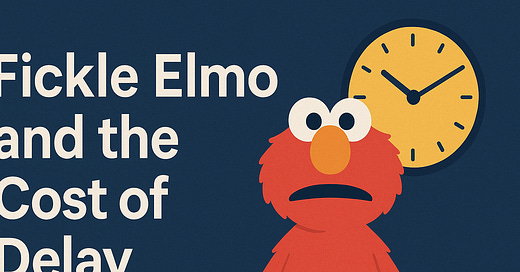Sorry Seems to Be the Hardest Word
When your brand is in the hot seat, every hour you wait to apologize is a deposit into the distrust account. From Elmo to xAI, this week showed how timing can make or break a leader’s credibility.
Leadership Moment: Fickle Elmo
If you weren’t paying attention, you might have missed the brief window last week when Elmo’s Twitter account posted vile, antisemitic content. It was ostensibly an account hack, and in one sense, Sesame Street is also a victim here. But they’re a victim who then victimized a lot of people. Usually, someone whose account is compromised quickly apologizes for the content, but, oddly, Sesame Street chose not to, instead merely deleting the content, and two days later, an odd, “Thank you for being kind to Elmo…” message.
Which was odd, given that the Internet had spent two days mocking Elmo, suggesting that Elmo was the new spokesmuppet for just about every antisemitic entity on the planet, from Hamas to various political movements. Only after even more outrage and mockery did Sesame Street post an apology and denunciation.
If you find yourself in this position, get out ahead of the firestorm with an apology. Waiting two days to apologize for the harm, especially for such a consumer-focused brand, is a failure of leadership.
Workshop: Selling to CISOs
In two weeks, I’ll be doing a workshop with Blumberg Capital, aimed primarily for cyber founders, on Selling to CISOs. Those interested should apply to join us at https://lu.ma/s13u7q0c, for this closed door (but virtual) event Tuesday, July 29, at noon Eastern (7 pm Israel). I’ll cover how to reconstruct your pitch into the key truths that CISOs need to believe before they’ll buy, common faux pas that get in your way, and how to authentically market, and sell, to the security buyers. (If you’re interested in bringing this, or related workshops, to your company, let me know).
Leadership Moment: Passing Through
I spent time this week downtown in Boston, working out of another firm’s office. When our meetings were over, I had an hour to kill, and, it being way too hot outside, stuck around catching up on email. The room I was in was hot (western wall plate glass windows made for an overloaded air handler), so I went looking for a different spot. Across the hall, in the building core, was the kitchen/lounge, and you could pass through it into a conference room connected to the other side of the building. The conference room being comfortable and cool, I set up there, and thought it’d be a quiet place.
Nope. Every couple of minutes someone would cut through the conference room headed to the kitchen. They’d get a few steps in, notice me, freeze, and apologize, then quickly continue. It entertained me, but I started just preempting their apologies: “Come on through!”
It was later that someone explained that the conference room was often used for interviews, so people thought I might have been a candidate, and their distress was triggered by fear of disrupting an interview.
In hindsight, while I wasn’t bothered by the cut-through, I hadn’t considered the effect it might be having on the folks who I was impacting.
One Minute Pro Tip: Memorize the KPIs
Chatting with a company this week, it came up that one team had a number of KPIs that took pages to document. No one could keep track of all of them, and executives weren’t clear on if any of the KPIs actually mattered. Certainly these were not key performance indicators for the business.
If you don’t have your KPIs memorized–not just what you’re tracking, but the current measure itself–then they aren’t key. Memorize your KPIs, and ditch the rest. Stop wasting energy collecting data that isn’t getting used.
Anti-Leadership Pattern: The Operating System Canvas
If you aren’t familiar with the OS Canvas (https://medium.com/the-ready/the-operating-system-canvas-420b8b4df062), it’s a framework for an exercise similar to the Start/Stop/Continue (S/S/C) team exercise. You have individuals write, usually on sticky notes, their concerns: things that get in their way, things they need, etc. In S/S/C, you brainstorm activities: what you think the org should start doing, what you should stop doing, and what you absolutely need to continue doing. In the OS Canvas, you document tensions (things that get in your way, so stop), and bright spots (things that are working well, so continue). Start activities are sometimes inferable from tensions, and this is a mixed blessing: you’re not asking participants to solve problems up front, but you can end up with convoluted tensions (“we don’t have a process to …” is just “stop not tackling this problem”).
Keep reading with a 7-day free trial
Subscribe to Duha One: Leadership in Minutes to keep reading this post and get 7 days of free access to the full post archives.



